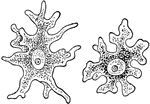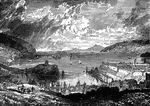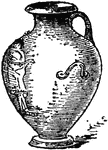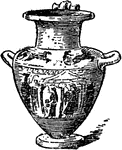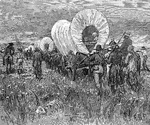
Western Train
"A western emigrant train. The occupation of the west. With every year the line of settlements was pushed…

Perna isognomum
"The Perna isognomum has a somewhat similar form to the Hammer Oyster; it lives in deep water,…

Jacques Cartier
Jacques Cartier, voyager of St. Malo, coasted along the north of Newfoundland in 1534 and passed through…
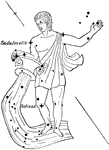
Aquarius
"A zodiacal constellation, supposed to represnt a man standing with his left hand extended upward, and…
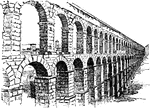
Aqueduct
"Aqueduct of Segovia, Spain. A conduit or channel for conducting water from one place to another."-Whitney,…
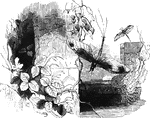
May Fly
"These insects are called Day-flies from the shortness of their existence in the perfect state;…

Boat Fly
"They carry the air required for their respiration in a space left for this purpose between the wings…

Water Scorpion
"The Nepa cinerea is a European example of this family, which may be met with there in every…
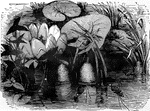
Spider, diving
"Another remarkable member of the Araneidae is the Diving Spider, Argyroneta aquatica, which…
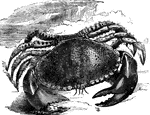
Common European crab
"These have the shell regularly rounded in front and narrowed behind; the legs are of moderate length,…
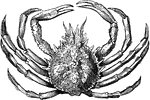
Spinous spider-crab
"In these the back is usually covered with spines and hairs. They generally live in deep water, and…
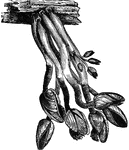
Barnacles
"The Common Barnacle, Lepas anatifera, perhaps the best-known example of the order, generally…

Carp
"Carp is a fresh-water fish. It is a native of Asia, but has been extensively introduced into the United…

Archerfish
"To this fish has been ascribed the power of shooting drops of water to the distance of 3 or 4 feet,…

Archimedean Screw
"A device for raising water, said to have been invented by Archimedes."-Whitney, 1902

Water Bear
"A water-Bear, or Bear-animalcule (Macrobiotus schultzei), one of the Arctisca or Tardigradam, much…

Diving Dress
"Diving Apparatuses are contrivances by means of which divers are enabled to remain a considerable time…

Drumfish
"Drumfish, or Drum, and other species of the same genus, fishes found on the Atlantic coasts of North…

Ducking Stool
"A Ducking Stool is a chair in which scolding and vixenish wives were formerly securely fastened, to…

Dugong
"The Dugong is an herbivorous mammal, belonging to the Manatees. It ranges from 10 to 20 feet in length.…

Steam Fire Engine
"A Fire Engine is a machine employed for throwing a jet of water for the purpose of extinguishing fires.…
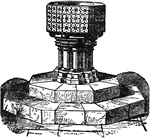
Baptismal Font
"A Font is the vessel which contains the water for the purpose of baptism. Fonts were required to be…
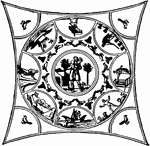
Fresco Ceiling
"A Fresco is a kind of painting performed on fresh plaster, or on a wall covered with mortar not quite…

Grayling
"The Grayling is a genus of fresh-water fishes in the salmon family, distinguished from trout, etc.,…
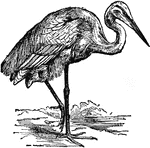
Heron
"Heron is the common name of birds of the genus Ardea. The herons are distinguished by having a long…
Electric Torpedo Boat
"Torpedo Boats are small vessels built for speed and fitted with tubes for firing torpedoes by either…

Common River Trout
"Trout is a term applied generally to various species of fishes belonging to the salmon family. The…
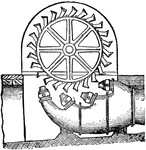
Pelton Wheel Turbine
"Turbine is, in mechanics, a term formerly confined to horizontal water wheels, the revolution of which…

Valerian
"Valerian is an order of herbs or rarely shrubs belonging to the division of monopetalous dicotyledons…
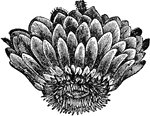
Victoria Regia
"Victoria Regia, named by Lindley after Queen Victoria, is the most magnificent of all known water lilies,…

Voltaic Pile
"Volta's arrangement for producing a current of electricity, consisting of a pile of alternate disks…

Wart Hog
"The Wart Hog closely resembles the true hogs in most of their characters, and particularly in their…

Hemlock Water Dropwort
"Water Dropwort is a genus of plants of the natural order Umbelliferæ. A number of species are…
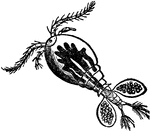
Cyclops communis Water Flea
"Water Flea is a popular name for minute aquatic Crustaceans such as daphnia, cypris, and cyclops. In…
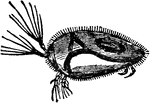
Cypris Unifasciata Water Flea
"Water Flea is a popular name for minute aquatic Crustaceans such as daphnia, cypris, and cyclops. In…

Daphnia Pulex Water Flea
"Water Flea is a popular name for minute aquatic Crustaceans such as daphnia, cypris, and cyclops. The…
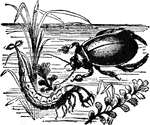
Water Beetle
"Water Beetles are beetles which live on or in the water. The Dytiscus, common in stagnant water, is…
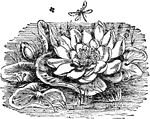
White Water Lily
"The Water Lily is an exogenous aquatic plant including eight genera, and all possessing submerged root…

Egg of Common Whelk
"Whelk is a popular name for a number of marine gasteropods, and especially applied to species of Buccinum…
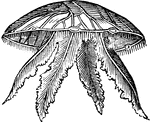
Medusa, aurita
"One of the commonest species, and must have been observed by those who frequent the sea-shore. In the…

Rhizostoma cuvieri
"The Rhisostoma Cuvieri, a British species, measures two feet, or ever more, in diameter, while…
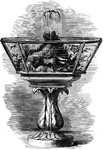
Fountain aquarium
"This is the Aquarium, consisting of a glass tank or fountain, usually of an oblong shape,…
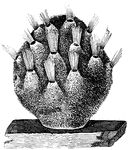
Living sponge, magnified
"A glace at a piece of common sponge will show that its surface is everywhere perforated with an infinite…
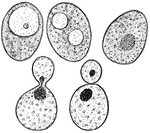
Yeast cake
"Showing a Bit of Common Yeast Cake when mixed with Water and examined under the Microscope. There are…
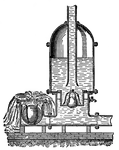
Hydraulic Ram
"The Hydraulic Ram is a machine for raising water, and depending for its action on the impulse of flowing…
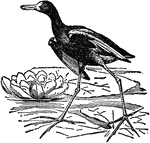
Jacana
"The Jacana is a wading bird; a genus of grallatores. They are very light birds; and the wide surface…

Lake Dwellings
"The earliest account of lake dwellings is to be found in Herodotus, who describes a Thracian tribe…
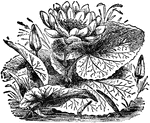
Egyptian Water Lily
"Lotus is a name given to various flowers, including several beautiful species of water lily, especially…

Water Opossom
"Opossom is the popular name for the pouched mammals which have a geographical range from the United…
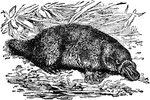
Ornithorhynchus
"Ornithorhynchus, commonly called duckbill or watermole, is a small quadruped found in Australia and…
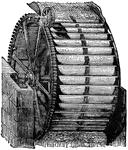
Overshot Wheel
"The Overshot wheel is a form of water wheel in which the water flows upon or near the top of the wheel.…
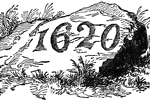
Plymouth Rock
"Plymouth is a town and county-seat of Plymouth co., Mass.; on Plymouth Bay, 37 miles S. E. of Boston.…

Chain Pump
"A Pump is a machine, engine, or device, consisting of an arrangement of a piston, cylinder, and valves,…
